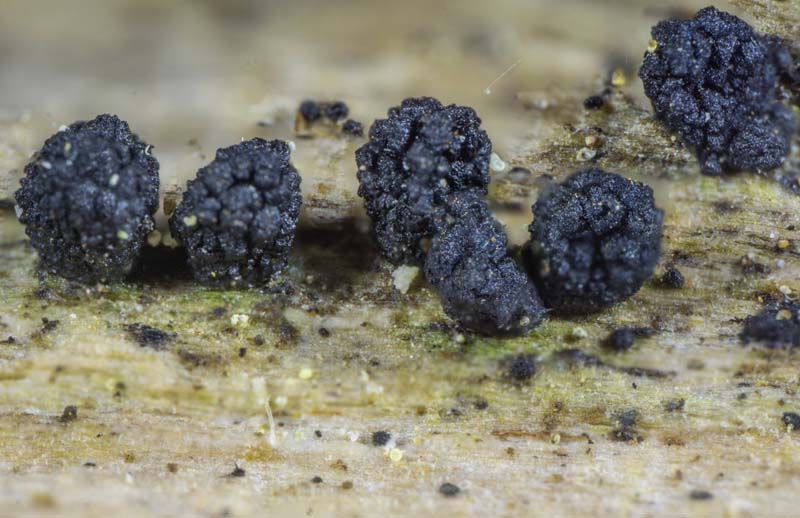
© Fred Rhoades
Danny’s DNA Discoveries – Other Sordariomycetes of the PNW
by Danny Miller
|
|
Danny’s DNA Discoveries – Other Sordariomycetes of the PNW
|
|
Introduction
The Sordariomycetes, sometimes known as flask fungi, make their asci inside little volcanos called perithecia, placed around the fertile surface like a bunch of pimples. The spaces between the perithecia are sterile. In a way, these fungi may be sacrificing quantity for quality, as the spores might be more forcibly ejected out the openings of the "volcanos" and travel further. The asexual stage of fungi do not have asci (asci are a sexual structure) and therefore if you find a Sordariomycete species in the asexual stage, it will not be pimpled, but you can often tell the sexual stage of a Sordariomycete by the pimpled surface. The large orders Hypocreales and Xylariales are found on separate pages. This page covers all of the smaller orders, whose species can resemble those found in the larger orders. abundant common uncommon rare - colour codes match my Pictorial Key and are my opinions and probably reflect my bias of living in W WA. Rare species may be locally common in certain places at certain times. |
|
Sordariomycetes - misc. orders I have not been able to independently verify which order these actually belong in.
Lasiosphaeria cf ovina EU (Sordariales) - tiny, white wooly balls, each with a black pimple, found on wood. Sexual. One ENA sequence is 3% different than one EU sequence. One CA collection of empty, black spheres (could have been just very old or could have been a different species) was 3% different than both. This suggests our PNW species needs a new name. We need local collections. Cytospora chrysosperma EU (Diaporthales) - I don't know how to tell this apart from Cytospora PNW01. One ID sequence matches many EU type area and other worldwide sequences by this name, but some matching sequences were named other species of Cytospora, so I can't be sure of the correct name. Asexual. The deprecated sexual form name is Valsa sordida. Cytospora PNW01 (Diaporthales) - rusty orange "moss" on wood. Asexual. This sequence is 10 bp different than the closest known species. unsequenced Lasiosphaeria ovina © Sava Krstic, Cytospora PNW01 © Betsy Knutson Keller
Neohypodiscus cf cerebrinus EU (Boliniales) - an irregularly hemispherical black carbonaceous pimpled mushroom on wood like many Xylariales, but apparently in a different order. Sexual. We have no DNA from anywhere yet. Bertia moriformis (Coronophorales) - like carbonaceous blackberries on wood, also similar to other Xylariales. Sexual. One CA collection matches a UK collection fairly well and probably represents this species, but we need local collections to see if it occurs up here or if local collections are all PNW01. Bertia PNW01 - our one PNW collection so far, from WA, is >10% different in ITS and has the fruitbodies more spaced out. Anisogramma anomala NY (Diaporthales) - filbert blight, causing longitudinal depressed black cankers on introduced eastern Corylus (hazelnut) trees, but rarely may be found on native hazelnut. Sexual. It apparently spread from ENA to the west in 1973. One OR sequence matches some probably ENA type area sequences. We need a photographed sequenced collection. unsequenced Neohypodiscus cerebrinus © Roo Vandegrift, Bertia moriformis (from CA) © Sadie Hickey, unsequenced Anisogramma anomala © Jeff Ward (2 images)
Sphaeronaemella cf helvellae EU (unknown order) - tiny yellowish hairs growing all over Gyromitra esculenta complex and G. infula complex mushrooms, giving them a velvety appearance. If you look closely each one is a tiny sphere with a long neck and not actually a hair. Even though this is a sexual fruitbody, it belongs to an order of Sordariomcyetes that produce tiny fruitbodies not large enough for a pimpled surface. This has been incorrectly placed in the Melanosporales as far as I can tell. We don't have any type area sequences, but we do have one AB sequence that might be this (not of the one shown). Helminthosphaeria cf clavariarum EU (Sordariales) - the white coral Clavulina is very susceptible to this grey mold. There are also white corals that can turn naturally grey. For the parasite sexual stage, you should be able to see the tiny black dots of the pimpled grey mold under a hand lens that wouldn't normally be there if it was just a grey fruitbody. For the asexual stage without the black pimples, it might be harder to tell if you have a parasite or a naturally grey coral, but the greying due to the parasite should be more irregular. Ironically, whereas we often try to sequence a mushroom and accidentally get an invisible parasite on it sequenced instead, we tried to sequence the parasite on this mushroom and accidentally get the white coral sequenced instead. We're trying again. Ophiostoma PNW01 (Ophiostomales) - this asexual mold was sequenced on a decaying Cryptoporus volvatus fruitbody in WA, so this genus is represented here, but they are probably nondescript molds. unsequenced Sphaeronaemella helvellae © John Plischke, unsequenced Helminthosphaeria clavariarum on sequenced Clavulina 'coralloides PNW01' © Yi-Min Wang |